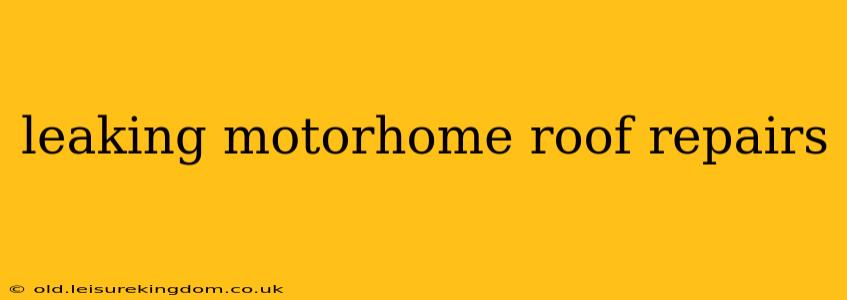A leaking motorhome roof can quickly turn a dream vacation into a soggy nightmare. Water damage not only ruins your trip but can also lead to extensive and costly repairs if left untreated. This comprehensive guide will walk you through identifying the source of the leak, selecting the right repair method, and preventing future leaks. We'll even address some frequently asked questions to ensure you're fully equipped to tackle this common motorhome problem.
Identifying the Source of the Leak
Before you even think about repairs, pinpointing the exact location of the leak is crucial. This often requires a systematic approach:
- Visual Inspection: Start with a thorough visual inspection of the roof, both inside and out. Look for any obvious signs of damage, such as cracks, punctures, loose sealant, or deteriorated caulking around seams, vents, skylights, or air conditioners. A helpful trick is to use a garden hose to carefully simulate rainfall, observing where water enters. Someone inside the motorhome should simultaneously check for leaks.
- Water Testing (the Hose Method): This involves systematically spraying sections of the roof with a garden hose while someone inside monitors for leaks. Start with the suspect areas identified during the visual inspection. If the leak is subtle, consider using a dye in the water to better trace its path.
- Interior Inspection: Carefully examine the ceiling and walls for water stains, discoloration, or bubbling paint. These are telltale signs of past or present leaks and can help you narrow down the search area.
Common Causes of Motorhome Roof Leaks
Understanding the common culprits behind leaking motorhome roofs will help you focus your efforts on the most probable areas:
- Sealant Failure: Over time, sealant around roof fixtures (vents, skylights, air conditioners) degrades and cracks, allowing water penetration. This is by far the most frequent cause of leaks.
- Cracks and Punctures: Impacts from branches, hail, or other debris can create cracks or punctures in the roof material.
- Poorly Installed Components: Improper installation of roof vents, skylights, or air conditioners can leave gaps that compromise the roof's watertight seal.
- Roof Material Degradation: Exposure to UV rays, extreme temperatures, and other environmental factors can weaken and degrade the roof material itself, making it susceptible to leaks.
Repairing a Leaking Motorhome Roof: Techniques and Materials
The repair method depends on the type and severity of the leak. Here are some common techniques:
- Resealing Seams and Fixtures: This often involves removing old, deteriorated sealant, cleaning the area thoroughly, and applying fresh sealant. Use a high-quality, UV-resistant sealant specifically designed for RV roofs. A caulking gun is an essential tool for this job.
- Patching Cracks and Punctures: Small cracks or punctures can usually be repaired with a patching kit, which typically includes a patching material and sealant. Clean the affected area carefully before applying the patch.
- Replacing Damaged Sections: For larger areas of damage or significant deterioration, replacing the affected section of the roof may be necessary. This is a more complex repair that often requires professional expertise.
What Type of Sealant Should I Use for My RV Roof?
Many RV owners swear by Dicor, a brand specifically formulated for RV roofs. However, other high-quality sealants are available, so consider factors such as the roof material and the specific application when making your choice. Always follow the manufacturer's instructions carefully.
How Much Does it Cost to Repair a Leaking RV Roof?
The cost varies widely depending on the extent of the damage, the type of repair required, and whether you DIY or hire a professional. Minor repairs might cost a few dollars for sealant, while major repairs could run into thousands. DIY repairs are generally cheaper, but professional repair offers peace of mind and may be necessary for complex problems.
Preventing Future Leaks
Regular maintenance is key to preventing leaks. This includes:
- Regular Inspections: Inspect your roof at least twice a year, checking for any signs of damage, loose sealant, or other potential problems.
- Sealant Maintenance: Reapply sealant around seams and fixtures as needed to prevent cracking and deterioration.
- Cleaning the Roof: Clean your roof regularly to remove dirt, debris, and other contaminants that can damage the roof material.
By following these steps and taking proactive measures, you can keep your motorhome roof watertight and ensure many years of enjoyable travel. Remember, addressing a leak promptly is crucial to prevent more extensive and costly damage.

